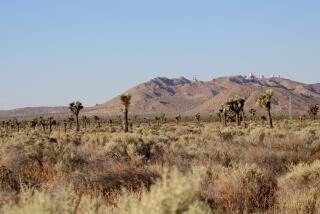California’s clean energy future threatened by federal delays, state officials say
- Share via
Reporting from Sacramento — Plans for a massive expansion of clean energy in California are being jeopardized by federal foot-dragging, according to state officials who say that more than 20 nearly shovel-ready solar and wind projects are being held up by the U.S. Department of Energy.
Seven major solar-mirror projects — enough to provide power to 3 million Southern California homes — along with plans for at least a dozen wind-turbine and solar-panel complexes have been cleared or almost cleared by state authorities and the U.S. Department of Interior.
The projects are valued at as much as $30 billion, according to estimates by Gov. Arnold Schwarzenegger’s office.
But the Department of Energy’s laborious procedures to guarantee loans threaten to stymie construction financing for many of the projects, and builders could lose out on more than $10 billion in federal stimulus funding if they can’t start digging by the end of the year.
At stake are more than 12,000 new, high-paying construction and manufacturing jobs and the opportunity to replace a large portion of the state’s fossil fuel-powered electric generation with nonpolluting energy.
Schwarzenegger, in a letter to Energy Secretary Steven Chu last week, said the delays in getting loans approved threatened state plans for a tenfold increase in solar-thermal power output, the biggest jump in almost 30 years.
“Without immediate and urgent attention from the DOE, many of these projects will not be financed and built,” Schwarzenegger wrote.
Chu’s agency said it was committed to speeding action on loan guarantees while still protecting taxpayers’ interests. It has streamlined environmental reviews, hired new management and improved communication with applicants. The changes should result in decisions on about six new loan guarantees by the end of the summer, said Department of Energy spokeswoman Ebony Meeks.
As part of the federal economic stimulus act, Congress charged the department with providing loan guarantees to renewable projects and authorized the U.S. Treasury Department to hand out stimulus subsidies of as much as 30% of the cost of building a new power plant once the guarantees are in place.
Complaints about the Energy Department’s handling of applications have been mounting. Although it has $77 billion available in loan guarantee funds, the department issued only one guarantee for $535 million and nine conditional guarantees as of April 10, the General Accountability Office said in a report early this month.
On Tuesday, the department announced it had approved a final loan guarantee for the Kahuku Wind Power project on the island of Oahu in Hawaii.
For California, the federal agency has issued a conditional loan guarantee to only one of eight pending solar-thermal applicants, the three-plant Ivanpah Solar Complex being developed by BrightSource Energy Inc. in the Mojave Desert near the Nevada border.
The Energy Department’s slow pace in approving loan guarantees also is worrying some private solar power developers, the California Energy Commission, U.S. Sen. Dianne Feinstein (D-San Francisco) and other powerful lawmakers and the GAO, the federal watchdog agency.
But not all of California’s alternative energy developers are waiting for federal assistance before they start building. On Tuesday, Terra-Gen Power officially broke ground on its $1.2-billion Alta Wind Energy Center in the Tehachapi Mountains in Kern County — closing financing without a federal loan guarantee.
For many large projects, however, the loan guarantees and subsidies are key to successful financing plans, experts said. The deep recession tightened credit markets, driving developers to seek federal help getting low-interest loans. Guarantees provide lenders and investors assurances that expensive renewable technologies can be commercially viable.
So far, the Energy Department has shown little urgency in approving guarantees, critics said.
Michael Picker, Schwarzenegger’s senior advisor for renewable energy facilities, said Energy Department officials told him in May that, nationwide, they were processing only two loan applications a month and that they expected to boost the monthly total to five next year.
“We’re really concerned that a lot of the projects won’t get built because they can’t get the cheap loans they’d get if the department … could give assurances in a timely fashion,” Picker said.
The GAO concluded that the department’s loan guarantee program “has treated applicants inconsistently and lacks mechanisms to identify and address their concerns.”
Feinstein has written three letters to Chu since October complaining about delays in approving loan guarantees. At an April 28 Senate subcommittee hearing, she called herself “an unhappy senator from California” as she publicly castigated the energy secretary.
“The Department of Energy simply has not fixed the problems that I believed a commitment was made to fix,” she said.
To reiterate their displeasure and to goad the department into action, Feinstein and her committee colleagues last week directed the agency, as part of next year’s budget, to address the GAO’s concerns “expeditiously” and report back to lawmakers in 90 days.
Feinstein said that Chu, in a recent meeting with her, committed to communicating more frequently with loan guarantee applicants and to coordinate better with other federal agencies. But she said she still had “serious concerns” about the department’s failure to meet deadlines and what she sees as a bias against California projects.
Such coordination is badly needed to make sure that projects that are ready or close to being approved can start construction by the end of the year, said John Clapp, chief financial officer for Solar Trust of America.
The Cleveland company is close to starting work on two Mojave Desert projects, one near Blythe and one near Palm Springs, that could generate a total of 1,500 megawatts. Each is expected to cost about $1.5 billion and needs federal loan guarantees and subsidies to garner financing.
The Mojave region, Clapp said, is one of the best places in the world for generating thermal power.
It “would certainly help to move things along faster,” he said. “My fear is it hasn’t happened yet.”
More to Read
Inside the business of entertainment
The Wide Shot brings you news, analysis and insights on everything from streaming wars to production — and what it all means for the future.
You may occasionally receive promotional content from the Los Angeles Times.











